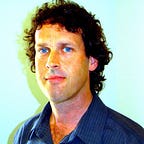Local Peer-to-Peer Energy Grids Create Lightbulb Moment
As neighbors sell their excess power to each other, new possibilities for sharing emerge.
If you want to get a good look at the future of the sharing economy, travel to an organic farm in the Netherlands.
There, at the homestead where Arie and Gina Noordemeer live with their four children and five Highland cattle, a giant windmill whirs day and night. The windmill towers over fields of potatoes, carrots, corn and Brussels sprouts. It also supplies enough energy to not just power the Noordemeer farm, but also provide energy to approximately 600 other Dutch households. It’s part of the Vanderbron energy network, an online peer-to-peer marketplace making renewable energy available on mass scale. If you’re a member of the Vanderbron system, which the Noordemeers are, you can sell your excess power yield directly to buyers across the country. Farm-to-table has been replaced with farm-to-meter.
While the sharing economy may evoke car rides in Manhattan or a comfy room in Manhattan Beach, its scope is becoming larger and more diverse all the time. Increasingly, it’s moving into local energy markets. All over the world, small but powerful local power grids are forming, allowing neighbors to generate, buy, and sell excess power.
For more than a century, the electric grid relied almost exclusively on a massive centralized infrastructure, with large power plants and long-distance transmission lines doing the work. Now, with customers able to buy and sell excess energy resources, these distributed energy resources (DERs) are forever changing the economic landscape of the power sector.
“The peer-to-peer concept keeps growing and diversifying,” said Peter van de Glind, in a recent interview he and Harmen van Sprang gave to Reinvent. Van de Glind and Sprang are the co-founder of shareNL, a knowledge and networking platform for the Netherlands, and they’ve seen how much the sharing economy grew and what it can mean to people. “This is a big opportunity,” van de Glind noted. “It gives more agency and power to take control over your own life.”
A solar panel farm grows in Brooklyn
The current, well, powerhouse in the peer-to-peer energy transactions market is Brooklyn Microgrid. The miniature utility grid connects people who have solar panels on their roofs in the Boerum Hill, Gowanus, and Park Slope neighborhoods in Brooklyn with neighbors who want to buy locally generated green energy. Like other microgrids, it operates alongside, but separate from, the traditional energy grid.
The project is the offspring of LO3 Energy, which funds the Brooklyn Microgrid project. LO3 Energy created a system that lets people buy and sell locally generated solar energy within their communities. The system uses blockchain technology — the digital ledger technology that underpins the digital currency bitcoin — to count up every unit of energy created by the distributed energy systems. Those energy units are then made available on the open market, where they are bought and sold in the local community. Participants install smart meters equipped with the technology, which track the energy they generate and consume.
Blockchain makes the Brooklyn Microgrid possible, said LO3 Energy founder Lawrence Orsini. “Blockchain is a really good communications protocol for what we want to do,” he said at the recent Business of Blockchain conference, organized by MIT Technology Review and the MIT Media Lab. “This isn’t just about settling energy bills. It’s about self-organizing at the grid edge.”
Microgrid users can choose exactly what they want to pay or where they want to get their energy from. Or they can simply opt for an automated “set and forget” control system.
While the Brooklyn Microgrid’s short-term goal was to operate as a backup option during power disruptions such as storms, its success led to loftier long-term goals, including setting consumers on a path to fully owning the electricity their community generates, and even potentially encouraging increased investment in renewable energy options.
Blending the old and the new
Now LO3 Energy has grander plans, and is set to open an office in Australia. As in the US, the plan is not to compete with the major utilities, but to partner with them to develop and prove the technologies and then integrate the peer-to-peer trading network naturally into the market.
And LO3 is not the only company looking to develop peer-to-peer energy trading in Australia. Power Ledger began a similar, albeit very limited, operation between a few apartments at a housing complex in Freemantle and another at a retirement village in Busselton. LO3 arrives, though, with the advantage of having demonstrated several years of success in Brooklyn. Both companies, however, face a battle in Australia, where proponents argue that outdated regulations have stymied efforts aimed at community energy sharing and distribution.
Still, if they get in tight with the new construction market, it could be a massive boost. New apartment complexes, for instance, could create a growing series of localized peer-to-peer energy trading ecosystems.
Around the world, similar market experiments are popping up. The UK’s first peer-to-peer renewables energy trading platform launched last year. Called Piclo, it’s a collaboration between cleantech company Open Utility and renewable supplier Good Energy. Piclo is designed to create a marketplace for energy generators and buyers. Solar, hydro, and wind generation sites from across England, Scotland, and Wales have signed up. Good Energy says it will also buy up any surplus power generated by its customers, and provide energy from its own network when supply is low.
The key to these changing markets, as van de Glin notes, is to look at the new energy grids systems not as something to supplant existing businesses, but one that will complement them. He believes that co-existence is key to the existence of legacy companies and emerging sharing platforms. The goal, he says, is to “integrate the collaborative economy into the existing economy….It’s about changing human behaviors and pairing the old with the new.”
